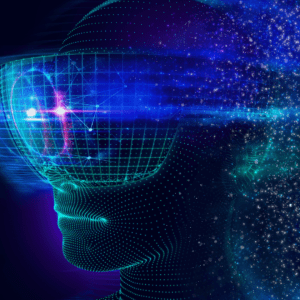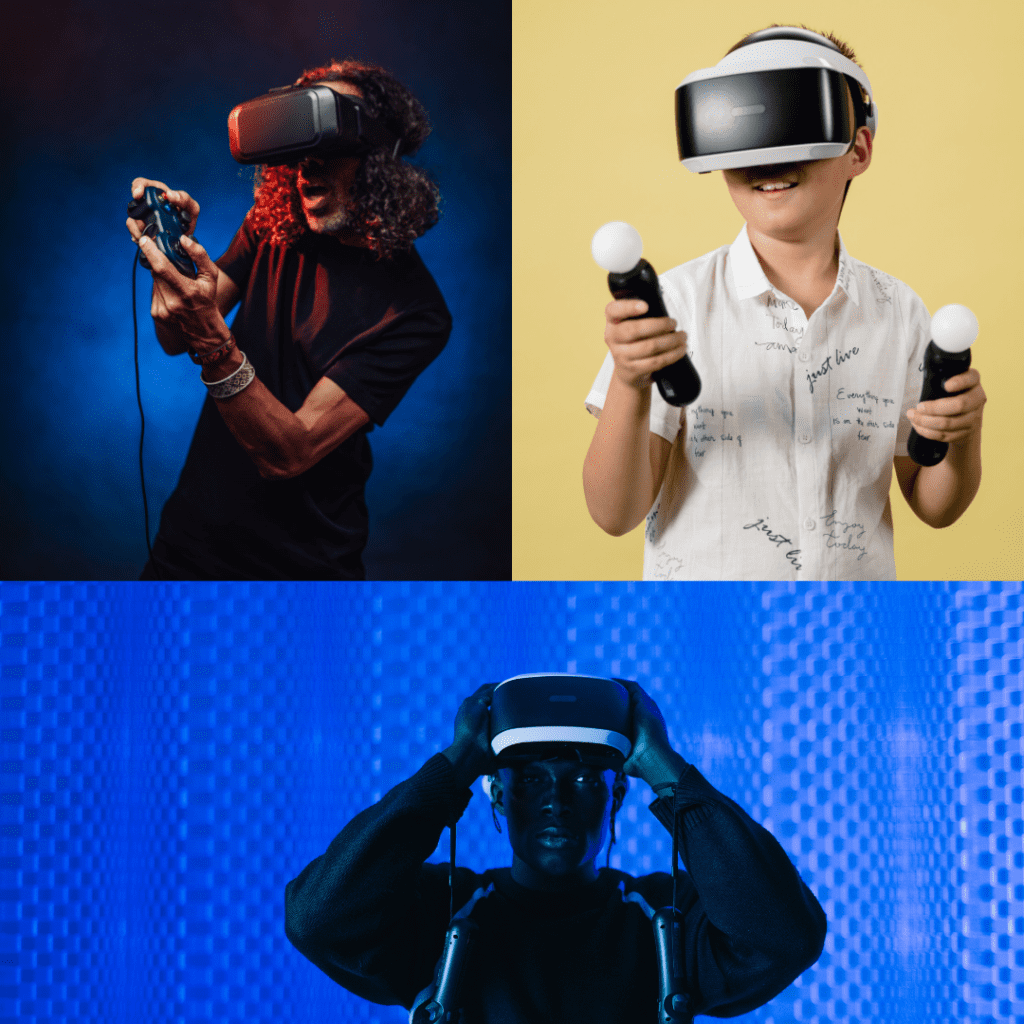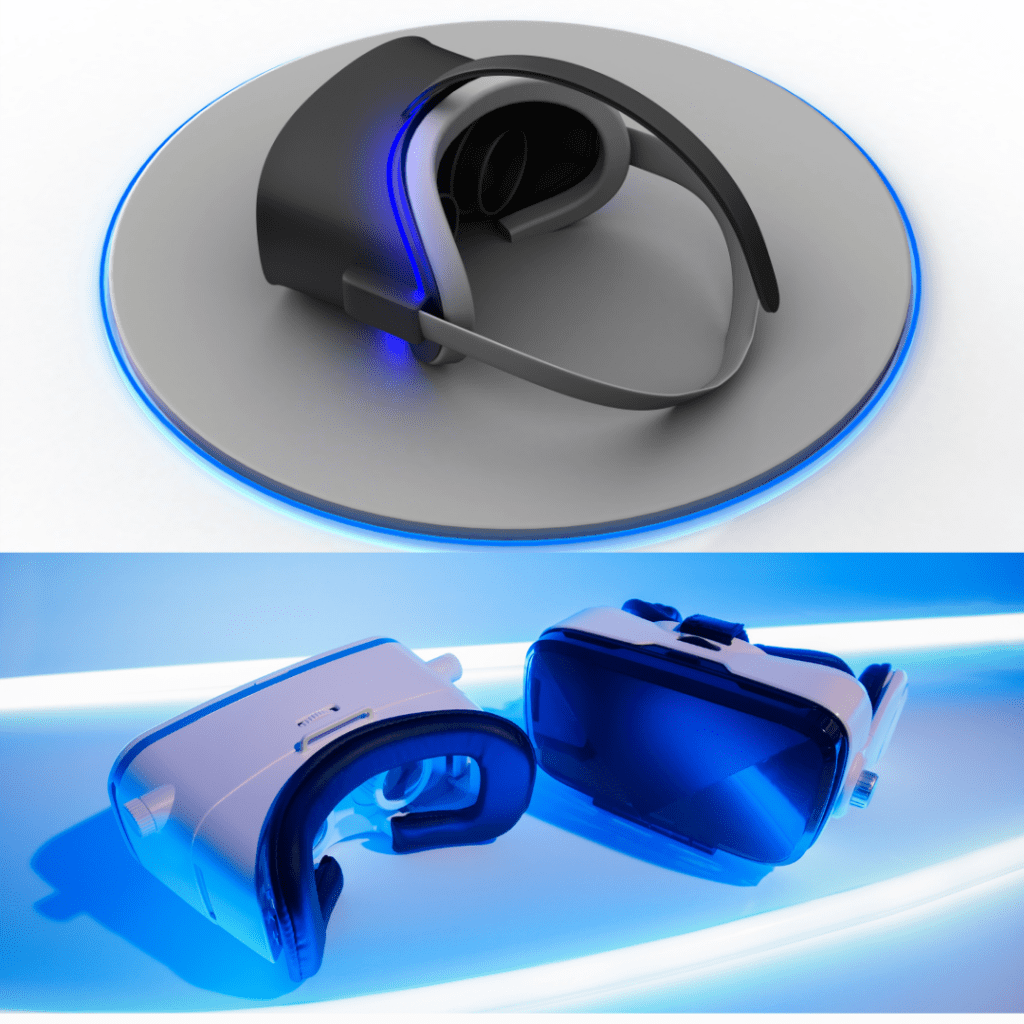- Made In INDIA

Lets first try to understand Virtual reality – Virtual reality or (VR) as it is commonly called is a computer-generated simulation that creates a fully immersive artificial environment, tricking the user’s senses into believing they are somewhere else. It allows users to interact with and manipulate objects in this virtual world through VR headsets and controllers, enabling unique and engaging experiences across various applications.
For example, in gaming, VR transports players into fantastical worlds, allowing them to experience and explore virtual environments as if they were physically present. From battling dragons in a fantasy realm to exploring the depths of the ocean, VR makes you feel like you’re actually there.
In education, VR can provide immersive learning experiences, such as virtual field trips or simulations of historical events or scientific concepts.
In training and simulations, VR offers a safe and cost-effective way to practice real-world scenarios, such as flight simulations for pilots or surgical simulations for medical students
So to summarize VR, it’s a technology that allows users to interact with an artificial three-dimensional (3-D) environment, it feels real, your senses are fully engaged and your surroundings respond to your every move.
But what exactly makes VR possible? How does this work ?The answer lies in a combination of ingenious hardware and clever software. hardware plays a crucial role in delivering immersive experiences.


At the core of any VR system lies its processing prowess, essential for rendering environments and tracking movements in real-time.
For basic VR experiences,handling tasks such as rendering simple graphics and basic physics calculations. entry-level CPUs like the Intel Core i5 or AMD Ryzen 5 will suffice,
However, upgrading to higher-tier CPUs such as the Intel Core i7 or AMD Ryzen 7 is recommended for advanced VR applications, enabling smoother gameplay and enhanced graphics.
Regarding GPUs, mid-range options like the NVIDIA GeForce GTX 1060 or AMD Radeon RX 580 support entry-level VR experiences adequately. Yet, for advanced applications, upgrading to more powerful GPUs like the NVIDIA GeForce RTX 30 series or AMD Radeon RX 6000 series is advisable. These GPUs deliver superior performance, enabling users to enjoy immersive VR experiences with stunning visuals and minimal latency.
In summary, while entry-level components suffice for basic VR, upgrading to higher-tier CPUs and GPUs is recommended for optimal performance and immersion in advanced VR applications.
Ok, let’s have a quick recap on what we have seen so far, the topic of the podcast is about The Role of Hardware in Virtual Reality, we just saw the role of CPUs and GPUs so far, now let’s look at displays. Imagine this: you are on a heart-pounding climb up a VR mountain. Lush greens and a snow-capped peak fills your vision. But if the visuals are blurry or jerky, that epic view goes out the window.
That’s why VR displays are very crucial. They need super-sharp resolutions and lightning-fast response times to trick your brain into believing the virtual world is real. We need High refresh rates above 90Hz for that ultra-realistic feel. Its like flipping through a super-fast flipbook, we need to keep everything smooth and prevent motion sickness.
Colors are important too! OLED and LCD technologies bring vibrant scenes to life, making that virtual sunset a fiery masterpiece. Advanced optics ensure a clear view without distortion, and a wide field of view lets you feel truly immersed, not like you’re peeking through a keyhole.
Some VR headsets even use foveated rendering, a trick that focuses detail where you’re looking, saving power without sacrificing realism. So, next time you’re in VR, appreciate the amazing display and technology that is transporting you to incredible new worlds!


Now let’s look at tracking and sensors : One of the key elements of VR hardware is its ability to track movements accurately. This is achieved through a combination of sensors, including accelerometers, gyroscopes, and positional tracking systems.
These sensors work together to capture the user’s motion in real-time, allowing for precise spatial awareness within the virtual environment. Advanced tracking solutions, such as inside-out tracking and lighthouse tracking, enable room-scale VR experiences with sub-millimeter accuracy.
Additionally, technologies like predictive algorithms and sensor fusion enhance tracking stability and responsiveness, ensuring a seamless and immersive VR experience.
Interacting with virtual environments requires intuitive input devices. Input devices are tools that bridge the gap between you and the virtual world.
From handheld controllers to motion-sensing gloves, VR hardware includes a variety of input options to enable natural and immersive interactions. These devices leverage technologies such as haptic feedback, capacitive touch sensing, and spatial tracking to provide users with precise control over their virtual surroundings.
Moreover, advancements in gesture recognition and hand tracking enable more natural interactions, allowing users to manipulate virtual objects with hand gestures and gestures accurately.


In the realm of virtual reality, user comfort is paramount. Wearing a VR headset for a long time can exact a physical toll on you, so giving meticulous attention to comfort and ergonomics is imperative in VR hardware design. By Utilizing lightweight materials, adjustable straps, and breathable fabrics, manufacturers craft headsets that fit comfortably to the user’s head so that they can minimize fatigue and discomfort during prolonged use.
But it’s not just about the materials; it’s also about the design philosophy. Ergonomic principles take center stage, ensuring optimal weight distribution and pressure relief to alleviate common issues like neck strain and headaches. By prioritizing user comfort, VR hardware designers facilitate prolonged immersion in virtual experiences without the encumbrance of discomfort or fatigue.
Ok with this we come to the end of the topic, To summarize everything we have seen how the role of hardware in virtual reality is indispensable. From processing power and graphics to tracking sensors and input devices along with design and ergonomics, every component contributes to creating an immersive and compelling VR experience. As technology continues to advance, we can expect VR hardware to become even more sophisticated, paving the way for new possibilities and applications across various industries.
©2024 Holoware® Computers Pvt. Ltd. | Privacy Policy | Terms & Condition
Roles & Responsibilities:
Preferred candidate profile:
Key Skills:
Location: Guindy & Porur
No of Openings: 3
Hindi Speaking is preferred
Fresher to 4 years experience in the relevant field is preferred.
Job description
We are seeking a motivated and detail-oriented Sales Coordinator to join our dynamic sales team. The Sales Coordinator will play a key role in supporting our sales representatives and ensuring smooth operations within the sales department. This position offers an exciting opportunity to contribute to the success of our sales initiatives and provide excellent customer service to our clients.
Role & responsibilities
Preferred candidate profile
Perks and benefits
Warranty Offers
Services with those steps are available
Solution With 24/7 Support
Get Started


In 1994, Mr.Thangavel started Origin Information Technology (in partnership with Mr. Loganathan) to provide quality computer hardware sales and service. In the year 2022, the company name was changed to “Tinkas Industries Private Limited” to encompass its diversified activities. Mr. Thangavel feels that he can give back to his nation the growth it needs in many ways like providing employment opportunities to many, and doing CSR activities, etc. His goal is to make Tinkas a leader at the National and Internaltional levels.
Holoware CEO abut Tinkas CEO
“The CEO of Tinkas (Mr.Thangavel) is undeniably one of the most practical and resourceful individuals I’ve encountered in Tamil Nadu. His profound understanding of the industry coupled with his diverse business ventures truly exemplifies his wealth of knowledge. Partnering with Tinkas has been a delight, and we eagerly anticipate further growth and collaboration.”
Mr. Ketan Patel is an indomitable entrepreneur revolutionizing the landscape of electronic consumer products worldwide through an unparalleled ‘experiential journey.’ Leading Creative Newtech since 1992, he steered its growth from a Mumbai market trader to a distributor and Brand Licensee. As an alumnus of IIM-Bangalore, Mr Patel leads Creative Newtech with a focus on innovation and strategic leadership. Under his three-decade leadership, Creative Newtech has become India’s market leader, expanding globally across Hong Kong, the Middle East, and the SAARC region.”
Holoware CEO abut Creative Newtech CEO
“The CEO of Creative (Mr.Ketan Patel) is a highly knowledgeable leader, renowned for his expertise in distributorship. His intuitive knack for product selection and sales strategies, both in India and abroad, is impressive. Creative thrives as a powerhouse, fueled by its diverse team and collective expertise. We eagerly look forward to a promising future and further success in our collaboration with Creative.”


Inmac Computers Private Limited is a trailblazing name in the realm of IT services and solutions. With a remarkable inception in 1992 by visionary entrepreneurs Girish Babu and Asha Girish Babu, our company has consistently remained at the forefront of technological innovation, setting new standards for excellence in the industry.
Holoware CEO abut Inmac CEO
“Inmac’s CEO (Mr.Girish Babu) is one of the most humble and generous individuals I’ve ever had the pleasure of meeting. His leadership has been instrumental in steering his team to success, not just in Maharashtra but across various regions in India. Their financial stability over the years speaks volumes about his capabilities. It’s truly a delight to collaborate with someone of his caliber. I look forward to continued partnership with Inmac.”